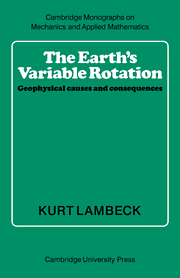Book contents
1 - A perspective
Published online by Cambridge University Press: 06 October 2009
Summary
A discussion on the Earth's rotation is conveniently separated into three parts: (i) precession and nutation, (ii) polar motion and (iii) changes in length-of-day (l.o.d.). Precession and nutation describes the rotational motion of the Earth in space and is a consequence of the lunar and solar gravitational attraction on the Earth's equatorial bulge. Polar motion, or wobble, is the motion of the rotation axis with respect to the Earth's crust. Changes in the l.o.d. are a measure of a variable speed of rotation about the instantaneous pole. We are primarily concerned here with the last two components of the motion.
The standard treatment of precession and nutation for a rigid Earth is that by Woolard (1953), but a more comprehensive treatment is by Kinoshita (1977). Observational evidence is discussed by Federov (1963). Further discussions are found in the symposium proceedings edited by Federov, Smith & Bender (1977). The main discrepancies between the observed and theoretical nutations are consequences of the presence of the liquid core. The problem of the precession and nutation of a shell with a liquid-filled spheroidal cavity continues to draw the attention of mathematicians and geophysicists (see, for example, Roberts & Stewartson 1965; Busse 1968; Toomre 1966, 1974). It is touched upon briefly in chapter 3.
Perturbations in the rotation from the rigid body state are caused by motions and deformations of the Earth by a variety of forces. Chapter 2 discusses some general aspects of the deformations of the solid part of the Earth.
- Type
- Chapter
- Information
- The Earth's Variable RotationGeophysical Causes and Consequences, pp. 1 - 5Publisher: Cambridge University PressPrint publication year: 1980

